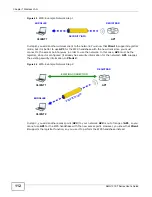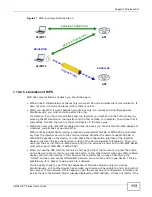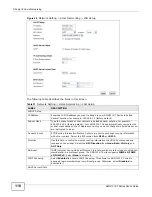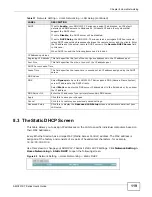
Chapter 7 Wireless LAN
AMG1312-T Series User’s Guide
106
7.10.3.4 Encryption
Wireless networks can use encryption to protect the information that is sent in the wireless
network. Encryption is like a secret code. If you do not know the secret code, you cannot
understand the message.
The types of encryption you can choose depend on the type of authentication. (See
for information about this.)
For example, if the wireless network has a RADIUS server, you can choose
WPA
or
WPA2
. If users
do not log in to the wireless network, you can choose no encryption,
Static WEP
,
WPA-PSK
, or
WPA2-PSK
.
Usually, you should set up the strongest encryption that every device in the wireless network
supports. For example, suppose you have a wireless network with the AMG1312-T Series and you
do not have a RADIUS server. Therefore, there is no authentication. Suppose the wireless network
has two devices. Device A only supports WEP, and device B supports WEP and WPA-PSK. Therefore,
you should set up
Static WEP
in the wireless network.
Note: It is recommended that wireless networks use
WPA-PSK
,
WPA
, or stronger
encryption. The other types of encryption are better than none at all, but it is still
possible for unauthorized wireless devices to figure out the original information
pretty quickly.
When you select
WPA2
or
WPA2-PSK
in your AMG1312-T Series, you can also select an option
(
WPA compatible
) to support WPA as well. In this case, if some of the devices support WPA and
some support WPA2, you should set up
WPA2-PSK
or
WPA2
(depending on the type of wireless
network login) and select the
WPA compatible
option in the AMG1312-T Series.
Many types of encryption use a key to protect the information in the wireless network. The longer
the key, the stronger the encryption. Every device in the wireless network must have the same key.
7.10.4 Signal Problems
Because wireless networks are radio networks, their signals are subject to limitations of distance,
interference and absorption.
Problems with distance occur when the two radios are too far apart. Problems with interference
occur when other radio waves interrupt the data signal. Interference may come from other radio
transmissions, such as military or air traffic control communications, or from machines that are
coincidental emitters such as electric motors or microwaves. Problems with absorption occur when
physical objects (such as thick walls) are between the two radios, muffling the signal.
Table 30
Types of Encryption for Each Type of Authentication
NO AUTHENTICATION
RADIUS SERVER
Weakest
No Security
WPA
Static WEP
WPA-PSK
Strongest
WPA2-PSK
WPA2
Содержание AMG1312-T Series
Страница 12: ...12 PART I User s Guide ...
Страница 13: ...13 ...
Страница 58: ...Chapter 4 Tutorials AMG1312 T Series User s Guide 58 Tutorial Advanced QoS Class Setup ...
Страница 61: ...61 PART II Technical Reference ...
Страница 62: ...62 ...
Страница 141: ...Chapter 10 Quality of Service QoS AMG1312 T Series User s Guide 141 Figure 67 QoS Class Setup Add Edit ...
















































